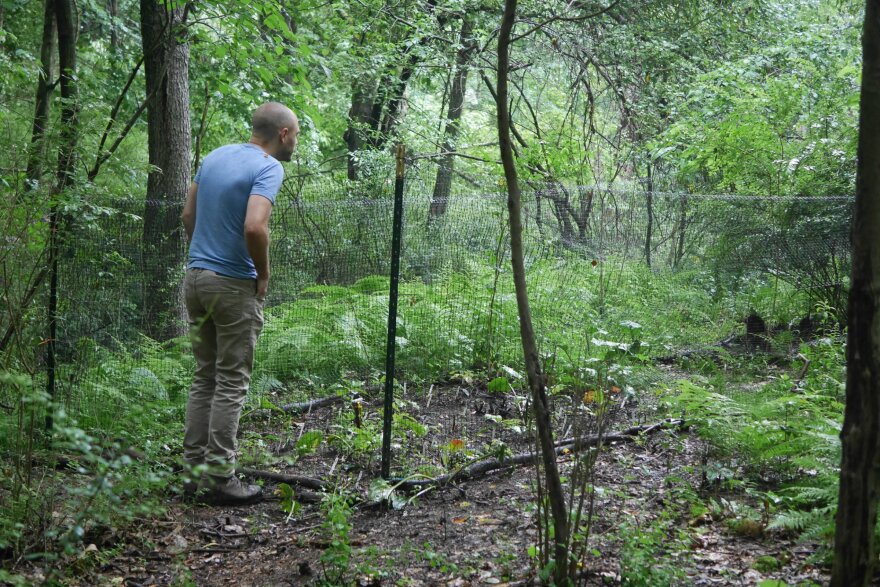Forests in our region are under attack from a shrub.
The culprit is an ornamental plant called Japanese barberry. It was introduced from Asia in the late 1800s. It’s been in used in landscaping in Michigan for decades, but it’s considered invasive.
I just found out I have some in my front yard.
They’re pretty, with bright red berries that birds love to eat.
And that’s where the problem comes in.
Joanne Foreman is with the Michigan Department of Natural Resources.
“What we are more concerned about is the fact that it is spreading in ways that no one anticipated,” says Foreman.
“The berries are favored by several birds and those birds drop those seeds, for instance, in open forest areas, and that barberry will take over really quickly. It tends to sprout early and take over a lot of ground, and that leaves no room for some of our native plants,” she says.
But wait - it gets worse. The branches have small thorns all over them. It makes a nice, safe little house for deer mice.
“Deer mice tend to host larval ticks, including those ticks that can be infected with Lyme disease,” says Foreman. “And when they find protection under Japanese barberry, their populations tend to increase.”
She says Japanese barberry is becoming a key invasive species in our state parks.
It’s not illegal to buy it in Michigan, but Foreman says it’s a buyer beware situation.
“We don’t say, 'no, you can’t buy it,' but we do want people to be informed of the invasive habit of the plant," she says.
She says if you want to get rid of the barberry in your yard, you can pull it out, put it in a dark plastic bag, seal it up, and put it in the trash.
But when Japanese barberry escapes into the wild, it can be a lot harder to get rid of. In Pennsylvania, there’s a woodlot where researchers are battling barberry.
Ryan Utz is a professor at Chatham University’s Falk School of Sustainability.
“This is what we call barberry hell. That’s going to be all that you see,” says Utz, walking through damp, forested land on campus.

Utz has some other choice words for the thorny, shoulder-high shrubs we see all along the tree line: he calls them insidious and alarming. That’s because of what’s beyond the wall of barberry.
"We have a nice population of mature oaks, cherries and red maples here. But based on our research, everywhere you see barberry, which as you can see right now is pretty much everywhere, there are no young trees underneath it,” he says.
Utz is dealing with a stubborn patch of barberry with some barberry busting tools.
He slices through the barberry stems with hedge trimmers, getting as close to the ground as possible.
"In areas where barberry remains uncontrolled, research has found that the incidence of ticks per acre that are infected with Lyme disease is actually much higher than in areas where it's being controlled."
“See that yellow stem material, that’s classic barberry, bright, bright, bright yellow,” says Utz.
Then grad student Art Link hooks up a propane tank to a small torch.
“What I like to do is actually go around and get a 360 burn,” says Link.
He slowly incinerates the cluster of barberry stems. The plant smolders. But Link says he’ll have to do it again. Barberry has been known to grow back even after it’s been torched.
Kelly Sitch is an ecologist with the Pennsylvania Bureau of Forestry.

He says the plant’s berries aren’t really nutritious for wildlife, the way that junk food isn’t ideal for people. And there's that thorny issue: barberry makes a home for mice, and the ticks they host.
“In areas where barberry remains uncontrolled, research has found that the incidence of ticks per acre that are infected with Lyme disease is actually much higher than in areas where it’s being controlled or where it’s not present in forests," says Sitch.
Kelly Sitch and Ryan Utz agree when it comes to the best way to keep Japanese barberry out of our region’s forests.
“Please, don’t buy barberry,” says Utz.
It’s been banned in some states, but many nurseries and big box stores still sell Japanese barberry for landscaping. Utz says there are other, non-invasive species of barberry available, and he’s a lot less prickly about those.
Kara Holsopple is with the environment news program, The Allegheny Front.





